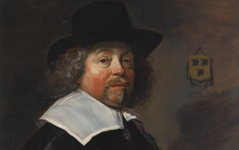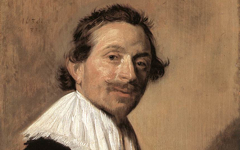Frans Hals’ Portrait of a Gentleman, half-length, in a black coat (early 1630’s)

Hals, Portrait of a Gentleman, half-length, in a black coat (early 1630's) Oil on canvas. Private Collection
Click image to enlarge.
This portrait of an unknown gentleman by Frans Hals was once owned by Elizabeth Taylor whose art dealer-father probably gave it to her in the 1950's. Its interest for us is that the artist did not place his FH monogram in a conventional spot, in a corner or on a piece of furniture, but on the shadow of the gentleman on the wall.
Click next thumbnail to continue
The monogram floats several inches from the right-hand edge of the canvas above the man's arm. Its considered placement thereby links the gentleman with the artist, strongly suggesting that Hals' is the gentleman's shadow or that underneath the image of a Dutch burgher lies the artist's alter ego.1
Click next thumbnail to continue

Left: Detail of Hals' Gentleman; Right: Detail of Hals' Self-portrait in a copy after the lost original (Indianapolis Museum of Art)
Click image to enlarge.
Although I wrote in the entry on Hals’ Portrait of Joseph Coymans that Hals' portraits seem relatively free of face fusion, I have recently noticed that some do share the artist's tired eyes with the bags under them. As for this comparison, if you ignore the noses and focus on other areas, there is considerable similarity, as in their eyebrows (short on the left, long on the right) and their protruding lower lips and chins.
Click next thumbnail to continue
Once recognized, other aspects take on new meaning. The eyes and hand, the most prominent details, almost certainly symbolize the artist's eye (perception) and hand (craft) while the two eyes - one light, one shaded - may refer to art's two forms of visual perception: normal vision in the left-hand eye underlined by a curve of light, insight in the other, shaded and underlined by a curved shadow. The man's shadow and monogram may even refer to the legend of the Maid of Corinth who drawing her lover's shadow on the wall discovered painting. All is made to look so normal, though, that the artistry in this magnificent portrait has probably never been seen (except, of course, by artists.)
More Works by Hals
Notes:
1. Microscopic analysis has confirmed that the monogram is original to the painting and is, therefore, an integral part of the composition. Christies Magazine, January 2012, pp.156-7
Original Publication Date on EPPH: 30 Jan 2012. | Updated: 0. © Simon Abrahams. Articles on this site are the copyright of Simon Abrahams. To use copyrighted material in print or other media for purposes beyond 'fair use', you must obtain permission from the copyright owner. Websites may link to this page without permission (please do) but may not reproduce the material on their own site without crediting Simon Abrahams and EPPH.




